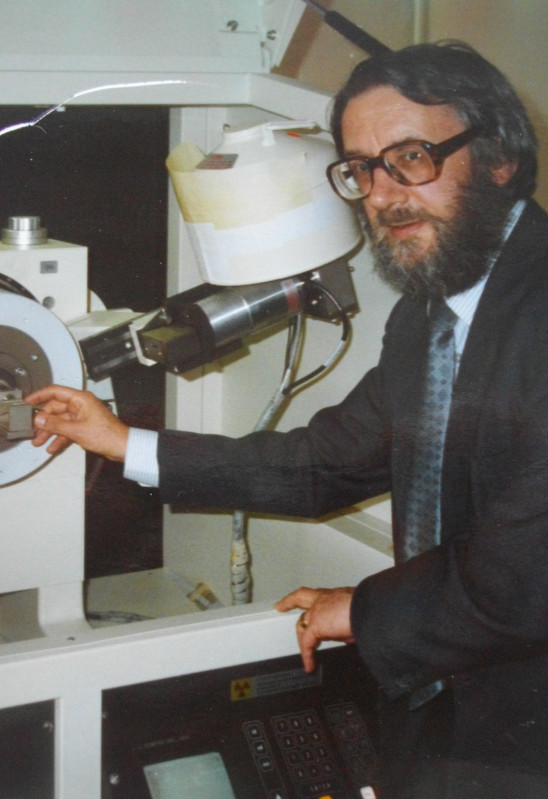Dr Brian Beagley
BSc Chemistry, 1959; PhD Chemistry (Crystallography), 1962; DSc Chemistry (incl. Physics), 1981
I was born in December in 1936 in Kensington, West London and grew up during WW2 in Fulham. Attended St John’s School, Dawes Road and the Sunday School at the Congregational Church next door. The Church was blitzed by Nazi bombing, thereafter I attended Hammersmith Broadway Congregational Church. I completed my primary education at St John’s, age eleven and in 1948 I won a Governor’s Scholarship to Latymer Upper School in Hammersmith, eventually specialising in science.
In 1954/55 I spent my school vacations working for LEO Computers Ltd. I won a State Scholarship in 1955/56 in Chemistry, Physics and both Pure and Applied Mathematics, and was accepted as a student in the Department of Chemistry at the University of Birmingham where I graduated with a BSc in 1959. I married Janet May Dowling (BSocSci, Birmingham) on 19 September 1959 in Hammersmith at the Broadway Congregational Church.
I then completed PhD studies on Determination of Crystal Structures by Xray Diffraction Methods (XRD) at Birmingham. On receiving my PhD in 1962, I was made a DSIR/NATO Fellow 1962-1964. I was headhunted in 1963 by Professor Durward Cruickshank who was interested, not only in my PhD research, but also in my pre-University experience gained working on the building of the LEO II computer.

Janet and I (as a NATO Fellow) moved to Oslo, Norway, in autumn 1963 where I joined Professor Otto Bastiansen’s Gas Phase Electron Diffraction (GED) Group at the University of Oslo. Returning to the UK in 1964, we moved to Kirkintilloch near Glasgow where I joined the academic staff in the Chemistry Department of the University, working for Professor Cruickshank. We had two children together; Sarah Helen Beagley born 30 August 1964 in London, and Philip Edwin Dowling Beagley, 12 July 1967 in Glasgow. Professor Cruickshank moved to UMIST (the University of Manchester Institute of Science and Technology) in 1967, and we followed him to Manchester in 1967, settling in Romiley, Stockport. I continued my work with Prof Cruickshank in the Chemistry Department at UMIST and in canal restoration (I’ll cover that below), while Janet took up employment in Child Care in Stockport. At UMIST, I progressed from Lecturer, to Senior Lecturer, then to Reader, finally retiring in 1996.
Community service
1960-1963: Janet and I worked alongside David Hutchings as volunteers during the restoration of the Southern Stratford Canal and whilst David Hutchings was the Chairman of the then Midlands Branch of the Inland Waterways Association.
1967-1974: When we returned from Norway and Glasgow to Manchester, I was appointed Chairman of the Peak Forest Canal Society in 1970. I led the campaign tor the reopening of the Cheshire Canal Ring, which involved spearheading the argument to persuade the authorities to restore the Peak Forest and Ashton Canals. These canals were restored and reopened in 1974. During this period, public awareness of the importance of canals as a valuable heritage was realised and much modern town-planning thereafter (e.g. in Birmingham) took account of canals as an open space (‘lung’) within the metropolis of a town centre (e.g. London, Manchester).

A more scientific biography:
Brian Beagley BSc, PhD, DSc, FRSC, MInstP, CChem, CPhys
Retired Reader in Chemistry, UMIST
He completed his PhD in X-ray Crystallography with R W H Small in 1962 at the University of Birmingham using the methods pioneered by Durward Cruickshank enabling analysis of the anisotropic motion of atoms in crystals. He was recruited by Cruickshank in 1963 to assist him in the gas-phase electron diffraction (GED) project to be set up upon Cruickshank’s move to the University of Glasgow. To this end, taking up a DSIR/NATO research fellowship, he spent 1963-1964 at the University of Oslo where he learnt their GED techniques under Professor O Bastiansen. In 1964 he joined the lecturing staff at Glasgow and took on responsibility for the GED laboratory, including structure determinations in the gas phase using the new GED equipment acquired by Cruickshank. He moved with Cruickshank to UMIST in 1967 setting up the GED equipment to provide a cross-UK GED service, which he continued to manage until Cruickshank retired in 1983. He was awarded his DSc by the University of Birmingham in 1981 and promoted to Reader in Chemistry at UMIST. He became leader of the Chemistry X-ray Diffraction group. He also did research in EXAFS spectroscopy using the Synchrotron Radiation Source at Daresbury Laboratory. He was a founder member of the British Crystallographic Association. His bibliography extends to some 160 publications on structural chemistry. He retired in 1996.
[This paragraph was used in the biography of Durward Cruickshank for the Royal Society, which Brian co-authored with John R Helliwell in 2018 . Biogr. Mems Fell. R. Soc. 65, 71-87(2018) ]
You could inspire our students